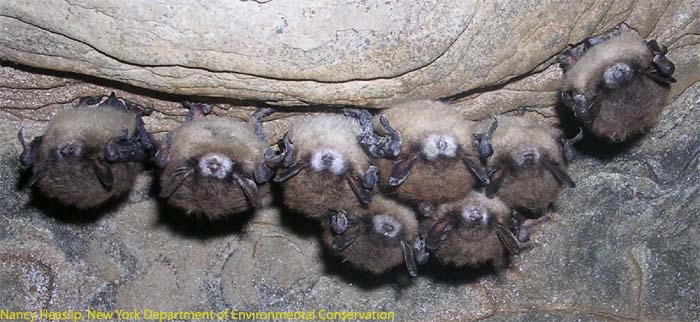
The White Death: North American Bats are Dying
White-nose Syndrome, a disease of hibernating bats, is spreading rapidly across eastern North America and as of March 2010 was confirmed in Ontario and Quebec. Bat populations are being devastated as over 90% mortality occurs in most affected caves and mines. To date, over a million dead bats have been associated with this fungal disease since it was first discovered in a single cave in New York in 2006. Already, some bat species have nearly disappeared from New York state.
The newly-described fungus now has a name - Geomyces destructans, but recently this same fungus was found in various European countries and may explain the limited biodiversity of bats in Europe. It seems likely that the fungus was transferred to North America inadvertently by humans. While bat-to-bat transmission appears to be the main mode of spread in eastern North America, potential further transfer by humans researching bats or going underground is possible. This has led to some eastern cave closures, and the US Fish and Wildlife Service recommending decontamination of all caving and bat research gear.
ALL EQUIPMENT USED UNDERGROUND IN EASTERN CAVES AND MINES OR IN CONTACT WITH BATS IN EASTERN N. AMERICA MUST NOT BE USED IN WESTERN N. AMERICA where WNS is not yet known to occur. Similar precautions should be taken with equipment used in Europe.
What can you do to help?
There are currently only two tools in the WNS tool box: Prevention and Decontamination.
Please help prevent the transfer of WNS to western Canada by keeping eastern caving gear in the east. In Ontario and Quebec, where WNS is now present, please decontaminate your gear between caves and mines, avoid going underground in affected areas, and avoid caves and mines where bats are known to hibernate. We do not know whether transmission occurs year-round, or just during winter months, so cavers are asked to follow WNS prevention guidelines year-round.If white powder is observed on bats, please decontaminate your equipment, leave the affected location, and contact the local wildlife agency as soon as possible.
If dead bats are found, please do the following:
Learning More and Staying Up to Date:
Research is ongoing, and new guidelines are likely to become available for anyone going underground. For up to date information, please visit the following links:
This information section provided courtesy of Alberta Bat Action Team and B.C. Bat Action Team.